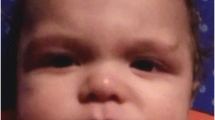Summary
A 10-month-old Japanese boy who had interstitial deletion of the long arm of chromosome No. 14; 46,XY, del(14)(pter»q24.3::q32.1»qter) is reported. A peculiar facial appearance, including round face, frontal hypertrichosis with thick eyebrows, horizontal narrow palpebral fissures, a short bulbous nose with a flat nasal root, and mild micrognathia, appeared to be common with the two previously reported cases. We stress the significance of this peculiar facial appearance in the diagnosis of 14q-(q24.3 to q32.1) syndrome. The level of α1-antitrypsin in the patient was only about half of that of his parents and controls, and the Pi locus was tentatively assigned to band 14q32.1.
Similar content being viewed by others
References
Camargo M, Cervenka J (1982) Patterns of DNA replication of human chromosomes. II. Replication map and replication model. Am J Hum Genet 34: 757–780
Chamberlin J, Magenis RE (1980) Parental origin of de novo chromosome rearrangements. Hum Genet 53: 343–347
Couturier J, Morichon-Delvallez N, Dutrillaux B (1985) Deletion of band 13q21 is compatible with normal phenotype. Hum Genet 70: 87–91
Cox DW, Markovic VD, Teshima IE (1982) Genes for immunoglobulin heavy chains and for α1-antitrypsin are localized to specific regions of chromosome 14q. Nature 297: 428–430
Hirabayashi Y, Futamatagawa O, Kubono K, Kawajiri K (1986) An automated turbidimetric immunoassay for transferrin, haptoglobin, α1-antitrypsin. Jpn J Clin Lab Automation (in press)
Hreidarsson SJ, Stamberg J (1983) Distal monosomy 14 not associated with ring formation. J Med Genet 20: 147–149
Ikeuchi T, Sasaki M (1979) Accumulation of early mitotic cells in ethidium bromide-treated human lymphocyte cultures. Proc Jpn Acad 55: 15–18
ISCN (1981) An international system for human cytogenetic nomenclature—high resolution banding (1981). Cytogenet Cell Genet 31: 16
Kawamura G, Suzuki M, Segawa T, Kohno S (1985) A case of partial monosomy of 14q. J Pediatr Pract (Jpn) 48: 32–34
Nielsen J, Homma A, Rasmussen K, Ried E, Sørensen K, Saldana-Garcia P (1978) Deletion 14q and pericentric inversion 14. J Med Genet 15: 236–238
Schroeder WT, Miller MF, Woo SLC, Saunders GF (1985) Chromosomal localization of the human α1-antitrypsin gene (PI) to 14q31-32. Am J Hum Genet 37: 868–872
Turleau C, de Grouchy J, Chavin-Colin F, Dore F, Seger J, Dautzenberg M, Arthuis M, Jeanson C (1984) Two patients with interstitial del(14q), one with features of Holt-Oram syndrome. Exclusion mapping of PI (alpha-1-antitrypsin). Ann Genet (Paris) 27: 237–240
van den Broek WGM, Hoffmann JJML, Dijkman JH (1976) A new, high frequency variant of α1-antitrypsin. Hum Genet 34: 17–22
Author information
Authors and Affiliations
Rights and permissions
About this article
Cite this article
Yamamoto, Y., Sawa, R., Okamoto, N. et al. Deletion 14q(q24.3 to q32.1) syndrome: significance of peculiar facial appearance in its diagnosis, and deletion mapping of (α1-antitrypsin). Hum Genet 74, 190–192 (1986). https://doi.org/10.1007/BF00282092
Received:
Issue Date:
DOI: https://doi.org/10.1007/BF00282092




